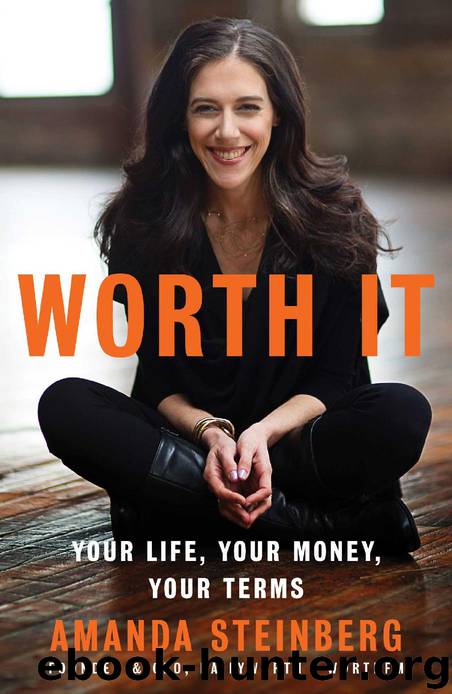Worth It: Your Life, Your Money, Your Terms by Amanda Steinberg

Author:Amanda Steinberg [Steinberg, Amanda]
Language: eng
Format: epub
Tags: Business, Self Help
ISBN: 9781501141010
Google: NDCzCwAAQBAJ
Amazon: 150114099X
Goodreads: 29430697
Publisher: North Star Way
Published: 2017-02-07T00:00:00+00:00
Age 35
10 percent bonds
90 percent stocks
Age 45
20 percent bonds
80 percent stocks
Age 55
40 percent bonds
60 percent stocks
Also, make sure you look for these features in any fund you choose:
• Solid track record: At least a five-year history with performance in at least the top 50 percent of its category and manager tenure of at least three to five years.
• Four or five star Morningstar rating: High Morningstar ratings are awarded to funds that have an impressive performance history with reasonable risk and cost. “Medalist” funds—those that receive gold, silver, and bronze analyst ratings—are likely to outperform their category peers and benchmarks on a risk-adjusted basis over market cycles of at least five years. See www.morningstar.com.
• “No-Load” means free of sales charges.
What You Can Actually Save
Let’s face it: the amount you need to save and invest every month might be more than what you can actually save and invest right now. Got big credit card debt? Got an emergency fund—one month’s worth of living expenses put aside? If you’re a freelancer or entrepreneur, are you saving regularly for taxes? Because you are going to be pulled in all directions when you first start thinking about what to do and how to do it, I’ll give you my three rules of thumb:
1. Have at least one month’s worth of living expenses saved in your emergency fund so you have cash on hand. Ideally work toward three months.
2. Pay off your expensive credit card debt first, or at least pay it way, way down. And stop getting into more debt (use your emergency fund to avoid more debt).
3. If your employer offers matching funds on your 401(k) plan, make sure you are contributing enough to get the maximum match.
If you don’t have any of these things, begin by setting up the accounts. Like an empty coffee mug awaiting the morning pour. But focus on your debt first. If you’re aiming for 5 percent returns on your investments while also paying 15 percent fees on your credit cards, you’re not helping your net worth. Check the math. Even if your $10,000 investment earns 5 percent ($500) as you’re paying 15 percent on $10,000 worth of debt ($1,500), the cost of that debt is three times your investment gains. Don’t do that. You won’t get out of debt quickly and you won’t build your 401(k), IRA, or other accounts efficiently. You’ll be working against yourself.
So have that emergency fund stocked. And when you dip into it—that’s what it’s for, after all—be sure to build it back up.
Emergency fund first. Debt second. Retirement third. Investments fourth.
Ridiculously Easy Cash Cows
Now, you might be thinking, okay, Amanda, I’m down with investing my money. I know why and how. But I’m just so—fill in the blank: busy/overwhelmed/risk averse/in the dark—that I’m going to hire a financial advisor in here to make sure it’s done right. Stop right there. Women who face their fears of investing do much, much better than those who don’t. Makes sense, right? For some, it can help to have a financial advisor.
Download
This site does not store any files on its server. We only index and link to content provided by other sites. Please contact the content providers to delete copyright contents if any and email us, we'll remove relevant links or contents immediately.
The Compound Effect by Darren Hardy(8735)
Tools of Titans by Timothy Ferriss(8157)
Nudge - Improving Decisions about Health, Wealth, and Happiness by Thaler Sunstein(7461)
Win Bigly by Scott Adams(7033)
Deep Work by Cal Newport(6820)
Rich Dad Poor Dad by Robert T. Kiyosaki(6319)
Pioneering Portfolio Management by David F. Swensen(6170)
Principles: Life and Work by Ray Dalio(6132)
The Barefoot Investor by Scott Pape(5648)
Digital Minimalism by Cal Newport;(5588)
Grit by Angela Duckworth(5449)
The Slight Edge by Jeff Olson(5316)
Discipline Equals Freedom by Jocko Willink(5241)
The Motivation Myth by Jeff Haden(5125)
You Are a Badass at Making Money by Jen Sincero(4732)
The Four Tendencies by Gretchen Rubin(4515)
Eat That Frog! by Brian Tracy(4387)
The Confidence Code by Katty Kay(4160)
Bullshit Jobs by David Graeber(3995)
